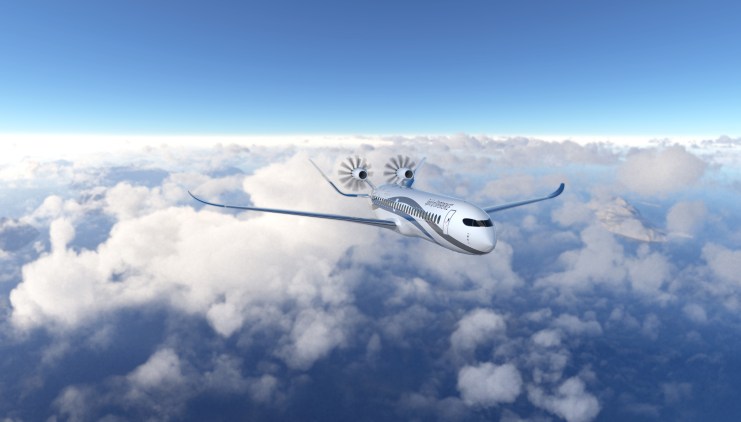
How virtual twin technology is powering low carbon aviation

The clock is ticking when it comes to preventing irreversible damage from climate change – and aerospace is one industry where a complete transformation is required to achieve Net Zero Targets.
With air travel currently contributing 2.5% of global greenhouse gas (GHG) emissions, it is high time to reinvent the way we fly, and decarbonisation is taking a leading role in the aviation industry’s efforts to combat climate change. In fact, it’s thought that aviation could consume up to one-sixth of the remaining temperature budget required to limit warming to 1.5˚C by 2050 unless significant changes are made.
Over the years, companies have ramped up efforts to decarbonise, while staying profitable amidst significant time and technological development challenges. In fact, the global air transport industry is committed to achieving net-zero carbon emissions by 2050. Although air travel has had many positive effects, such as allowing people to discover the world, it’s clear that this must be met.
It’s clear that the industry faces increasing societal, environmental, and economic imperatives for reinventing the way planes fly and reducing emissions – and this move towards enhanced sustainability will require new ways of managing products and services over their entire lifecycle: from design, use and end-of-life.
The power of the virtual twin
To do this, we at Dassault Systèmes are currently focused on creating new ways of working that create decarbonisation, drive competitiveness and responsible growth opportunities and collectively ensure that technological revolutions within aerospace deliver on their promise of enhanced sustainability.
For example, the 3DEXPERIENCE® platform and the Virtual Twin Experience from Dassault Systèmes can help accelerate the development and deployment of hydrogen aircraft technologies for either propulsive or non-propulsive energy systems.
The Virtual Twin Experience can help the industry’s decarbonisation, providing the digital expression of a product or industrial system’s full definition in the way that it is shaped as well as the way it behaves and interacts with other hydrogen subsystems. It starts from the earliest planning and design stages of its lifecycle all the way through to manufacturing, certification, sustainment and disposal. Virtual Twins enable aviation companies to explore scenarios in a collaborative manner, predict future behaviours and deliver the right solution, at scale, from the very first time.
The Virtual Twin Experience capability can accelerate aircraft prototype testing. By simulating advanced 3D designs based on real-life scenarios, stakeholders can virtually test, validate and accurately predict an aircraft feature’s performance well before production. This way, they can easily obtain critical validation right at the design stage while reducing emissions, costs, waste and use of resources.They also will have the opportunity to upskill operators in a safe environment while minimising the risks of upscaling to new technologies.
Besides accelerating hydrogen aircraft design, the platform also enables companies to improve daily operations – such as easy optimisation of supply chain and airport processes while accelerating hydrogen technology adoption and aviation decarbonisation efforts.
With these capabilities combined, Virtual Twins offer many benefits. Unlimited simulation allows for manufacturers to experiment digitally and determine the most sustainable ways of operating, before applying this to real-world operations as part of a continuous improvement process.
It also makes use of the end-to-end visibility on a single platform to source and manage raw materials, to optimise material combinations at the molecular level and reduce carbon emissions in the process.
Supporting manufacturer’s sustainability choices
While there are many possible technological levers today such as sustainable aviation fuels (SAFs), hydrogen fuel and electrical aviation, the winners of the race to net zero will be those that build the right ecosystem around the use of these levers.
Virtual Twin technology can support whichever decarbonisation route a manufacturer chooses to go down. For example, it can leverage a single source of truth to streamline ongoing research and development (R&D) collaboration on hydrogen fuel or use scenario planning to safely plan and execute hydrogen fuel transportation and optimise storage capabilities at airports and filling systems.
Thanks to Virtual Twin technology, low-carbon flights can become a reality. Aviation companies can create live virtual replicas of hydrogen fuel, sustainable aviation fuel (SAFs) and electric aircraft technologies for propulsive and non-propulsive energy systems. They can plan and test them at any point in the supply chain – all before real-life application. In doing so, they effectively deliver better fuels, better planes – whilst also creating a more robust value network.
Dassault Systèmeswill be demonstrating its virtual twin technology at this year’s Farnborough International Air show (July 18th – 22nd 2022). To find out more, please visit: https://events.3ds.com/farnborough-international-airshow-2022